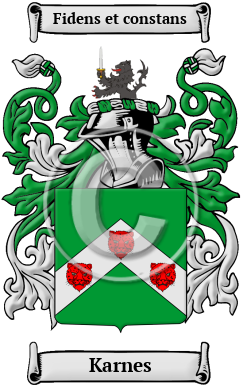| ![Show Contents]() Karnes History, Family Crest & Coats of Arms Karnes History, Family Crest & Coats of Arms
- Origins Available:
Ireland
Etymology of KarnesWhat does the name Karnes mean? Gaelic, otherwise known as Early Modern Irish, was used in Ireland from around the year 1200 until the 18th century. It is from this language that we found the first references to the name Karnes as Ó Ciarain or Mac Ciarain. These names are derived from the word "ciar," which means "black" or "dark brown." 1 Early Origins of the Karnes familyThe surname Karnes was first found in County Mayo (Irish: Maigh Eo) located on the West coast of the Republic of Ireland in the province of Connacht, where they held a family seat from ancient times. Early History of the Karnes familyThis web page shows only a small excerpt of our Karnes research. Another 87 words (6 lines of text) are included under the topic Early Karnes History in all our PDF Extended History products and printed products wherever possible. Karnes Spelling VariationsPronunciation, rather than spelling, guided scribes and church officials when recording names during the Middle Ages. This practice often resulted in one person's name being recorded under several different spellings. Numerous spelling variations of the surname Karnes are preserved in these old documents. The various spellings of the name that were found include Kieran, O'Kieran, Keiran, Keighran, O'Keiran, Kerin and many more. Early Notables of the Karnes familyMore information is included under the topic Early Karnes Notables in all our PDF Extended History products and printed products wherever possible. Karnes Rankingthe United States, the name Karnes is the 5,665th most popular surname with an estimated 4,974 people with that name. 2
| Karnes migration to the United States | + |
A massive amount of Ireland's native population left the island in the 19th century for North America and Australia in hopes of finding more opportunities and an escape from discrimination and oppression. A great portion of these migrants arrived on the eastern shores of the North American continent. Although they were generally poor and destitute, and, therefore, again discriminated against, these Irish people were heartily welcomed for the hard labor involved in the construction of railroads, canals, roadways, and buildings. Many others were put to work in the newly established factories or agricultural projects that were so essential to the development of what would become two of the wealthiest nations in the world. The Great Potato Famine during the late 1840s initiated the largest wave of Iris immigration. Early North American immigration and passenger lists have revealed a number of people bearing the name Karnes or a variant listed above:
Karnes Settlers in United States in the 19th Century- J Karnes, who landed in San Francisco, California in 1850 3
- Mary Karnes, aged 23, who landed in America, in 1896
Karnes Settlers in United States in the 20th Century- William Jefferson Karnes, who immigrated to the United States, in 1904
- Mrs. W. Les Karnes, aged 42, who immigrated to America, in 1905
- W. Les Karnes, aged 45, who landed in America, in 1905
- Luna Karnes, aged 35, who immigrated to the United States, in 1908
- William Lee Karnes, aged 30, who landed in America, in 1910
- ... (More are available in all our PDF Extended History products and printed products wherever possible.)
| Contemporary Notables of the name Karnes (post 1700) | + |
- David Kemp Karnes (1948-2020), American politician, businessman, and attorney, United States Senator from Nebraska from 1987 to 1989, President and Chief Executive Officer of The Fairmont Group
- Brixton Karnes (b. 1970), American actor
- Karen Karnes, American ceramist
- Robert A. Karnes (1917-1979), prolific television actor
- Henry Wax Karnes (1812-1840), American soldier and figure of the Texas Revolution
- Jay Karnes (b. 1963), American actor
- Dave Karnes (b. 1958), American Marine, rescuer of several survivors of the September 11, 2001 attacks
- Sergeant James Ernest "Buck" Karnes (1889-1966), United States Army soldier who received the Medal of Honor
- T. D. Karnes, American Democratic Party politician, Alternate Delegate to Democratic National Convention from Illinois, 1932, 1936, 1940 4
- ... (Another 3 notables are available in all our PDF Extended History products and printed products wherever possible.)
| Historic Events for the Karnes family | + |
- Mrs. Claire Karnes (d. 1912), (née Bennett), aged 28, American Second Class passenger from Pittsburgh, Pennsylvania who sailed aboard the RMS Titanic and died in the sinking 5
The motto was originally a war cry or slogan. Mottoes first began to be shown with arms in the 14th and 15th centuries, but were not in general use until the 17th century. Thus the oldest coats of arms generally do not include a motto. Mottoes seldom form part of the grant of arms: Under most heraldic authorities, a motto is an optional component of the coat of arms, and can be added to or changed at will; many families have chosen not to display a motto.
Motto: Fidens et constans
Motto Translation: Stand firm on trust.
- MacLysaght, Edward, The Surnames of Ireland. Ireland: Irish Academic Press, sixth edition, 1985. Print. (ISBN 0-7165-2366-3)
- "What are the 5,000 Most Common Last Names in the U.S.?". NameCensus.com, https://namecensus.com/last-names/
- Filby, P. William, Meyer, Mary K., Passenger and immigration lists index : a guide to published arrival records of about 500,000 passengers who came to the United States and Canada in the seventeenth, eighteenth, and nineteenth centuries. 1982-1985 Cumulated Supplements in Four Volumes Detroit, Mich. : Gale Research Co., 1985, Print (ISBN 0-8103-1795-8)
- The Political Graveyard: Alphabetical Name Index. (Retrieved 2015, October 6) . Retrieved from http://politicalgraveyard.com/alpha/index.html
- Titanic Passenger List - Titanic Facts. (Retrieved 2016, July 13) . Retrieved from http://www.titanicfacts.net/titanic-passenger-list.html
 |

